Approaching biological responsiveness: Combining the strengths of enterprise and university, “functionality socks” are born.
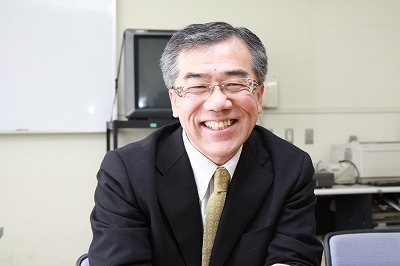
In this edition of Research NOW, we interviewed Professor Yukio Urabe, Department of Physical Therapy and Occupational Therapy Sciences, Health Sciences Major, Graduate School of Health Sciences.
(2010 February 19th, Interviewed by Community Collaboration, Information Policy Office, and Public Relations Group)
Profile
For young Urabe, who had been doing track and field until his senior year of high school, it was his dream to one day become a physical education teacher. However, when he injured his Achilles tendon in his senior year of high school, that dream was shattered. Although he was no longer able to teach sports, he desperately searched for another route that involved sports, and stumbled across physiotherapy. He proceeded by entering the Kochi Rehabilitation University Physical Therapy Faculty.
After graduating, he became a physical therapist at Public Noto General Hospital, and succeeded that by becoming an assistant professor at the Sapporo Medical University School of Medicine, Department of Physical Therapy. In 1993, after arriving at the Hiroshima University Faculty of Medicine, Institute of Health Sciences, he enrolled as a Graduate School of Medicine (orthopedic surgery) research student. In 2002, he received a doctorate for his research in ligament damage to the knee, and joint sprains in the foot. Recently, at events such as the Universiade tournament and the National Athletic Meets’ swim meet and gymnastics competitions, he has been supporting many athletes as an athletic trainer. Also, at the Nagano Olympics, he was appointed as a physical therapist by the Japanese National Team.
Figuring out how to draw out further medical treatment methods is the key
When athletes snap or damage a ligament in their knee, a comeback includes a lot of distress, and a long, painful rehabilitation session awaits them after the surgery.
“I want to relieve them of any mental and physical pain they feel! What can I do to achieve that?” Frankly, damage to the ligament in the knee occurs frequently as a result of traffic accidents and sports, so the advancement of this research is not only important for the athlete or sports aficionado, but can be applied to the general public or elderly.
“How should we decide on the treatment method?”
“What should we do about the sequence of the treatment?” Having to select from a choice of 100 best treatment methods that apply to any given person, a scientific selection must be made for each individual case. As he sees the injured patients undergo painful rehabilitation as part of their treatment, he contemplates: “what can be done to avoid injury?”
How to avoid injury?
After sports, to recover from your state of fatigue and to prevent any accidents, it is important to take part in cool down exercises. Despite knowing that it is better to maintain your condition by taking part in light exercises, Professor says that there are still many athletes and amateurs who claim to be too tired and do not want to move anymore.
For this purpose, Professor worked with Maruzen Co, Ltd (CEO Aihara) to develop an equipment called “Rakkun Walk,” that just by riding it, you are getting some light exercise in. Although it was originally designed with the intent to help athletes cool down, it can be applied to help joints in the foot (ankles) to improve, and is expected to help the elderly with health maintenance, and after applying modifications one after another, it finally became a viable product.
Website for Maruzen Co, Ltd is right here. (Japanese Page)
Cooperation with other enterprises, and the establishment of a venture business
Ankle dorsal extension (bending the ankle) becomes more difficult as you age, and the tendency to have difficulty standing up, or even falling down increases. Continuing to exercise your ankle joints is essential for daily movements such as walking, running, and sports. The use of “Rakkun Walk” can be thought to maintain your health using your feet. Just by riding it, you can get in simple exercise for your ankles, and can expect to never experience difficulty walking.
Report of the press conference of “Rakkun Walk R-1” (Japanese Page)
To begin selling the “Rakkun Walk,” professor Urabe founded Sports Rehabilitation System Ltd (A Hiroshima University launched venture business) in August, 2006 from a local bank, and was introduced to a managing director at Pearl Star Co. Ltd.
Click here to take a glance at the Hiroshima University venture businesses. (Japanese Page)
The encounter with a company that said “We want to build a product based off your ideas!”
Pearl Star Co. is a company that manufactures socks. When managing director Mr. Shintaku succeeded the business, as it was a subcontracted enterprise, its achievements had been suffering at the hands of international businesses that produce cheap goods with cheap labor; it was in a situation where it was near bankruptcy.
However, in May of 2006, while watching a patient with artificial limbs from a close distance, as a precautionary measure to falling, he requested that rather than producing a bulky piece of equipment, we produce easy to use socks for the patients. Mr. Shintaku was afraid of the company falling to bankruptcy, and wanted to do what he can using the socks manufacturing business to help those who are troubled, and decided that if it could produce better results for the company that it was worth a try.
After having produced numerous prototypes and displaying them at the academic assembly hall, he received advice from many different people. But because of all the technical terms, Mr. Shintaku who could hardly understand half of the advice he received, decided it was time to begin studying the structure of the human foot. Unfortunately, as he began to understand more, he began to lose confidence in his ability to produce a pair of socks that would prevent the patient from tumbling over. Mr. Shintaku who was exhausted made a request to the bank: “I would like you to introduce me to someone who knows about ankle joints.”
Website for Pearl Star Co. Ltd (Japanese Page)
Industry-University cooperation synergy
To professor Urabe, who had been thinking of ways to somehow prevent the elderly from falling down, Mr. Shintaku’s concept of creating a pair of socks that would prevent the same problem was very interesting. Thus began the collaborative research on “a pair of socks that would keep the underfoot raised,” using a device that latches on your tiptoes.
“How should we keep the tiptoes raised?” “To what degree (a mild incline, or a steep incline) should we keep them raised?”
Two months of accumulating data by repeating tests on how the body moves, and reflecting on the results. The results for the measurement of preventing a collapse were very well received. Plus, the result that it stretches your toes led to an interesting connection to knee and lower back pain.
Mr. Shintaku’s idea, furthermore his strong will to not give up (after 70-80 attempts), and Professor Urabe’s research group that worked to produce results that could be understood by the general public allowed for the creation of the “stumble prevention socks” that would stabilize the patient after a mild falter. (Sold from October 2007)
The completed “stumble prevention socks” combines the uses of an inelastic fabric called the “tuck stitch,” and a very elastic fabric called the “rib stitch.” Because of the disparity of the stretchiness of both these knits, these need to be manufactured by hand so your toes feel like they curve up when you wear the sock. Professor Urabe’s group has accumulated data that this is a technological idea that other companies would be unable to copy. This was powerfully tagged by the industry-university as the “bankruptcy prevention socks.”
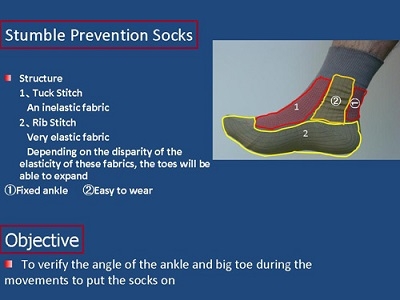
Challenging the bunion
The “bunion” is something that a quarter of all women are troubled by. According to Professor Urabe, a bunion is an illness where the foots big toe faces the outward direction, and along with it being a hereditary disease, can be caused by wearing tight high heels for a long period of time, or by being in an environment where you need to stand on your feet for a long time. Humans use their entire feet to maintain balance, so if your big toe faces outward, it becomes impossible to plant your feet using that toe, which destroys your center of gravity and leads to difficulty with walking. Again, the curved toes and joints are usually uncomfortably fitted into the shoe, which only causes more pain.
If this condition persists for too long, it seems that the other toes also lose the ability to function properly. On top of this, once you begin suffering from bunions, it does not heal naturally, so unless you undergo surgery, you can either use a medium layer between shoes and socks, or undergo physical therapy. However, physical therapy is a very time consuming activity, and most people are too busy to continue attending the sessions.
On top of this, women are susceptible to osteoporosis post-menstruation due to the low bone density, so if they fall, it is likely for them to break their femur bone in the base of their hip joint which is called a femoral neck fracture, and be bedridden. Because of the burden on the entire body and the resulting deterioration of exercise functionality, chronic diseases can grow worse, or one can suffer from new diseases, something that the elderly are susceptible to, which can take a toll on a person’s expected life span.
For an elderly person to fall, it is possible to be an accident that can be connected to a more dangerous outcome, which is why Professor Urabe decided to produce the “tumble deterrent socks.” Cooperating with Pearl Star Co, he has promoted the manufacture of a new “bunion counter-measurement socks.”
One day, Professor Urabe pressed on the abductor hallucis muscle (big toe) and came up with a groundbreaking idea to minimize the bunion production rate. “With what shall I press down on the abductor hallucis muscle?”
He concluded that it would be effective to sew on a pad to the socks on the region that is actually coming in contact with the shoe, so it only makes sense it wouldn’t hurt, and rids one of the feeling that there is anything on the foot to begin with. “What should I put on the inside of the pad?” First he attempted to put in a plastic ball, but this hurt and wouldn’t allow one to wear the shoes for long. He inserted various kinds of cloths in the pad, and accumulated data, created prototypes, and repeated. Some cloths would get wet from sweat, and dry up and cause chafing in the shoes, and again would cause pain if worn for a while. This continued for over a year and a half. And then at last, he came across a fabric that no matter how wet it got (with sweat) would not dry up. There was finally a method that even when worn, no pain would be felt, and thus the “bunion counter-measurement sock” was created. (Sold from November 2009)
Report of the press conference of the “Bunion counter-measurement sock” (Japanese Page)
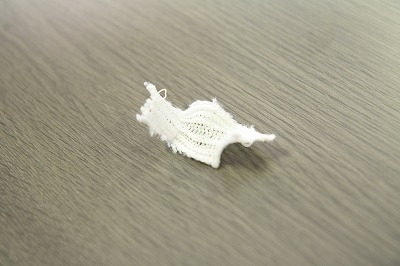
A rounded off version of this cloth is turned into a pad, and sewed in the socks.
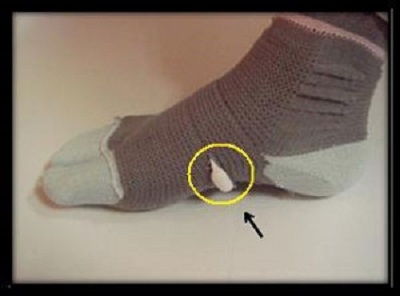
The bunion counter-measurement sock turned inside out. (The symbol points to where the abductor hallucis muscle is pressed.)
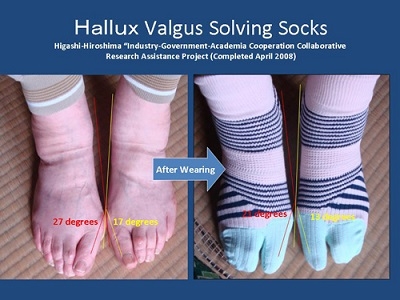
Before use (left), After use (right)
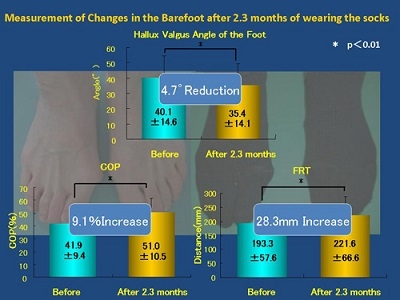
COP: Center of Pressure (the center of gravity should be situated along the entire foot, proportioned from the back of the foot.)
FRT: Functional Reach (Balancing ability)
P: Risk ratio 1% makes a big difference
A troublesome sprain
Ankle sprains are the most common sports-related injury, but people ignore the fact that it becomes “a habit,” or is “repeated frequently,” or that it is even an injury, and it has become a big problem that people are currently doing nothing about the pain. This field of medical treatment has not progressed in the last 20 years, according to Professor Urabe.
Professor and Mr. Shintaku powerful team conducted funded research at the Japan Science and Technology Agency, to produce a new trial product that would use a strap around the socks to fix clubbed feet and valgus feet.
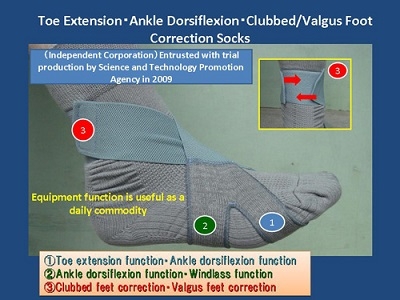
This field, which until now was attempting to fix these using shoes, has produced a pair of socks that can be worn indoors to grant the patient the independence to walk freely indoors, and also allow the patient to expect to have more opportunities to go out, all thanks to Professor Urabe.
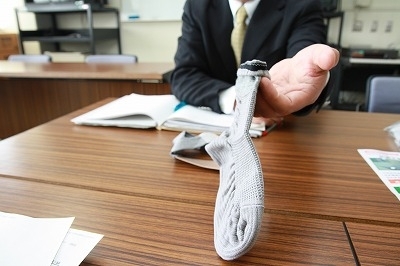
This was modified so that by folding back part of the sock, you can use just one hand to fit your feet in.
Postscript
After the press conference for Professor Urabe and his collaborative research with Pearl Star Co. Ltd on the “bunion counter-measurement sock,” the Public Relations group was flooded with mail and calls, so much that I was shocked to know there were so many people who were bothered by bunions. For the most part, the inquirers would say “It still hurts now. I want to try wearing the socks as soon as possible!” “Where can I buy one?” During this interview, “University and the industrial world joined hands to help people” and were able to bring about a shared happiness. “To all those who tried on this pair of socks! What are your thoughts regarding these socks?” (O)


 Home
Home

